Nakaoki in Mid-October
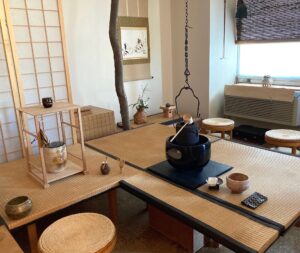
Ga-ran-dō, 伽蘭洞, Attend-orchid-cave, utensils and arrangement for a Tea presentation called Naka-oki, 中置, Middle-place. The portable fu-ro, 風炉, wind-hearth, has been placed on the area above the sunken ro, 炉, hearth (ro-dan, , hearth-foundation). The kama, 釜, kettle, has been suspended by a kusari, 鎖, chain, dispensing with the trivet-like go-toku, 五徳, five-virtues, simulating the absence of the supporting collar, koshiki, 甑, [wok] ring support, of the yatsure bu-ro, 窶れ風炉, timeworn wind-hearth.
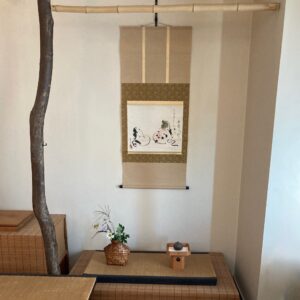
Garandō tokonoma with a kake-mono, 掛物, hang-thing, with a painting of Ebisu, god of fishermen, and an attendant maiden. Fishing creel basket with seasonal flowers, and an incense container in the form of a treasure jewel, displayed on a Shintō stand.
According to Japanese tradition, in the 10th month, all the Shintō kami, 神, gods, assemble at Izumo Tai-sha, 出雲大社, Out-cloud Great-shrine, to plan for the coming new year. This is the origin of the old name of Kan-na-zuki, 神無月, God-less-month, for the 10th month. That is except for Izumo area which is called Kami-ari-zuki, 神在月, Gods-have-month. Buddhist deities stay in their temples and shrines, so that much attention is paid to the activities of the Buddhists while the kami are in Izumo. I thought it would be appropriate to focus some attention on the activities of the kami. Although the kami are at Izumo, there is a great celebration and festivities dedicated to Ebisu, god of fishermen and merchants.
In Izumo there is an emphasis on Tō-kan-ya, 十日夜, Ten-day-night. This is a harvest festival held on the night of the tenth day of the tenth month (to send the rice paddy gods back to the mountains after harvest). There is wordplay on tōkanya, 当館や, merchant-hall, because Ebisu is worshiped by merchants for success in business. At Izumo Taisha, a dance is performed by the character of Ebisu.
Ebisu-kō is another event to worship Ebisu, one of the Seven Lucky Gods, and pray for prosperity in business, bountiful harvests, and safety in the home. It was originally held on October 20th of the lunar calendar, but now it is held on October 20th, November 20th, or January 10th Tōka Ebisu) of the Gregorian calendar
There is also an event called E-bi-su-kō, えびす講, lecture, club, association (Buddhist) lecture meeting religious association, this event is held at Buddhist temples on the 10th day of the 10th month, this was originally a lunar event and in recent times is observed on the solar calendar.
E-bi-su-kō, 恵比寿講, Bless-compare-longevity, is held to pray for the prosperity of business, which is the blessing of Ebisu-sama. Depending on how Ebisu-sama is called, the event may be described as ‘Ebisu-kō’. There are many ways to write ebisukō.
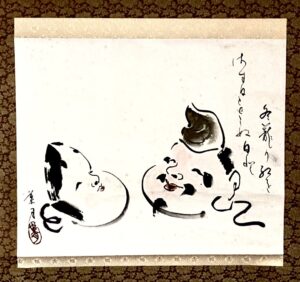
Painting of masks of E-bi-su-ten, 恵比寿天, Bless-like-longevity-heaven (Deva) and an attendant, Fuku musume, 福娘, Fortune daughter, with calligraphy (illegible). Signed, Ha-zuki, 葉月, Leaf-month (lunar calendar). The painting may have been created for the early January celebration and market of Tō-ka E-bi-su, 十日恵比須, 10-day Bless-like-longevity-heaven (Deva), held at shrines all over Japan. Shrine maiden’s dispense souvenirs of the event.
Ebisu in former times was called a i-hō-jin, 異邦人, strange-country-person, foreigner, a barbarian. There are theories for this name, though there are also other names and theories by which Ebisu is known. One is that Ebisu is Hiruko, 蛭子, Leech-child, the child of Izanami and Izanagi. Another is that he is Koto-shiro-nushi-kami, 事代主神, Matter-covert-master-god, the son of Ō-kuni-nushi-no-kami, O 大国主神, Great-country-master-god.
Ebisu is the god of fishermen, merchants, wealth, and one of the Shichi-fuku-jin, 七福神, Seven-fortune-gods. He holds a tsuri-sao, 釣竿, fish-rod, and a large fish called a tai, 鯛, sea bream, red snapper. There is wordplay on ‘tai’, in the expression, o-me-de-tai, お目出度い, hon.-eye-out-occur. The source is the open-eyedness of Daruma’s enlightenment.
Once colorfully painted, the figure was altered to its present state having been burned in a sacred shrine fire.
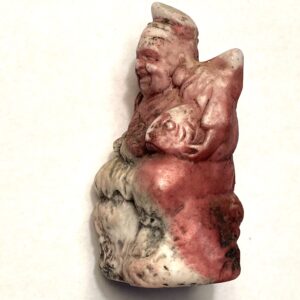
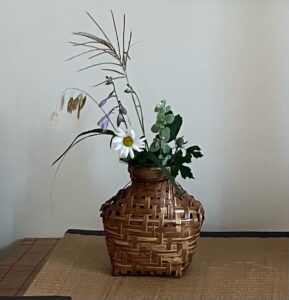
A hana-ire, 花入, flower-enter, displayed on tatami usually is placed on an usu-ita, 薄板, thin-board, however, baskets have a liner to hold water, so that the basket itself fulfils the function of an usuita. Flowers that bloom out of season may be displayed in the 10th month.
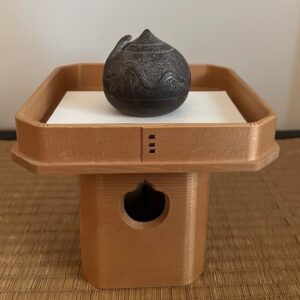
Kō-gō, 香合, incense-gather, stoneware covered ‘sphere’ in the form of a hō-ju, 宝珠, treasure-jewel, surmounted by an encircling snake, hebi, 蛇. Made for a Mi-doshi, 巳年, Snake-year. Bi-zen yaki, 備前焼, Provide-fore fired; h. 2.2 sun kane-jaku, by Ko-nishi Tō-zō, 小西陶蔵, Little-west Ceramic-treasury, Bizen.
The kōgō is displayed on a plain wooden Shin-tō san-pō, 三方, three-directions, and san-bō, 三宝, three-treasures. The sanbō exhibits the principle of the expression regarding the seams of objects, ‘maru mae kaku muko’, 丸前角向, round fore cornered oppose. The shō-men, 正面, true-face, of the tray faces deity. The shōmen of the base (unseen on the opposite side of the stand) faces deity.
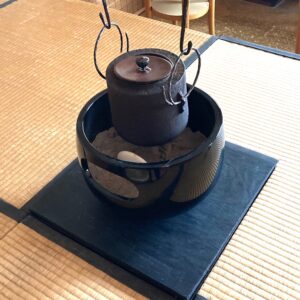
In Chanoyu, it is the custom to move the fu-ro, 風炉, with-hearth, to the middle of the utensil tatami, toward the end of the 10th month. This placement is called naka-oki, 中置, middle-place. It is thought that as the weather becomes colder with the approach of winter, the furo provides more heat for the comfort of the guests. This may have some truth, however, the furo can be used year round, and where there is no ro in the floor of the Tearoom, the furo is returned to the left side of the utensil tatami.
Some traditions place the furo on the location of the ro, which is a version of nakaoki. An important aspect of the traditional nakaoki, is the use of a temple size furo and kama made of tetsu, 鉄, iron. Most of the upper part of the furo has rusted away, so that the upper part of the furo no longer can support the kama. Such furo are called yatsure bu-ro, 窶れ風炉, timeworn wind-hearth. The ro kama is highly regarded, and rather than being discarded, is used as the kama for the sunken ro. Making use of the old large furo kama as the ro kama contributes solemnity to the ro.
There are three essential sacred offerings in Buddhism – kō ge tō, 香華灯, incense flowers lamps. These three are displayed on the altar, with kō-ro, 香炉, incense-hearth, in the center, naka-oki, 中置, middle-place. This has its equivalent in the tokonoma. During a Tea gathering, there is no kō-ro, 香炉, incense-hearth, displayed in the tokonoma together with a hanaire and a candle. The hearth, furo and ro, is the embodiment of the kōro, and provides the burner for incense. By its absence in the tokonoma, the Yō, 陽, Yang, positive nature of the incense, emphasized. The piece of flooring cut for the ro opening is the source of the ō-ita, 大板, large-board, used at times to support the furo.
In truth, the ro, or rather the i-ro-ri, 囲炉裏, inner-hearth-enclosure, was the center of the home centuries before the creation of the ro. It is believed that the Dō-jin-sai, 同仁斎, Both-benevolence-abstain, of the Tō-gu-dō, 東求堂, East-request-hall, at Gin-kaku-ji, 銀閣寺, Silver-pavilion-temple, was the first yojōhan room used to serve Chanoyu. The orthodox name of the temple is Ji-shō-ji, 慈照寺, Mercy-illuminate-temple, based on the posthumous Buddhist name of Ashi-kaga Yoshi-masa, 足利義政, Foot-advantage Righteous-govern.
The creation of the yojōhan exerted tremendous influence on Japanese architecture. Traditionally, most rooms had wooden floors, and tatami mats were unrolled for seating. In the Kamakura period, tatami could cover the entire room, or specific areas of floors. Thus developed the identifying a room size by the number of tatami, such as san-jō, 三畳, three-mat, yo-jō-han, 四畳半, four-mat-half, roku-jō, 六畳, six-mat, etc.
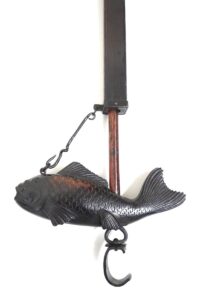
An ancient tradition in Japan is hanging a kettle for hot water over a fire in the i-ro-ri, 囲炉裏, enclose-hearth-inner, which is called a ji-zai kage, 自在鉤, self-exist hook. In Chanoyu, the hanging kettle is called a tsuri-gama, 釣釜, fish-kettle. The brace to hold the kettle in place is called a yoko-gi, 横木, side-wood, and is often in the shape of a fish or a sen-su, 扇子, fan-of. Rikyū had a bamboo pole to hang the kama, with the yokogi is called a ko-zaru, 小猿, little-monkey. The fish is modeled after Ebisu’s tai, 鯛, sea bream, which is appropriate as Ebisu is the god of fisherman.
The kama may be hung over the ro by a chain or bamboo or wooden pole; tsuri-gama, 釣釜, suspend-kettle. The chain or pole is hung from a hiru-kugi, 蛭釘, leech-hook, so-called because of the hook’s resemblance to the creature. The hook is secured above the ro in the ceiling, ten-jō, 天井, heaven-well. The boy, Ebisu, is the child of Izanami and Izanagi, he was unable to stand, and so he was put in a boat of camphor wood and set adrift on the Sea of Heaven.
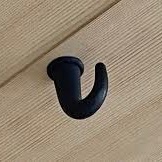
The dates of Ebisu-ko vary from region to region, but it is usually held on January 10, January 20, October 20, or November 20 every year, in the Kan-sai, 関西, Barrier-west. In the Kan-tō, 関東, Barrie-east. region, it tends to be held on January 20 and October 20.
The festival’s origins date back to the E-do, 江戸, Inlet-door, period. October 20 was Ebisu-ko, a day when merchants and their loved ones would celebrate Ebisu, the folkloric god of wealth. On October 19, in preparation for the next day, vendors would gather in front of the shrine of Takara-da E-bi-su-ten, 宝田 恵比寿天, Treasure-ricefield Bless-like-longevity-heaven (Deva), and sell items such as fish, vegetables and household shrines.
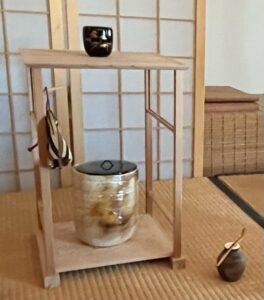
The plain wood display stand is a variation of the Ha-kkei Dana, 八景棚, Eight-views Shelf, created by I-guchi Kai-sen, 井口海仙, Well-opening Sea-hermit. The Hakkei dana can be assembled to approximate eight different styles of display stand. Iguchi Kaisen was the younger brother of Tan-tan-sai, 淡々斎, Fleeting-abstain, XIV Iemoto, Urasenke.
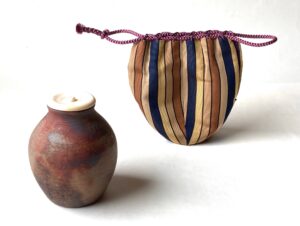
Cha-ire, 茶入, tea-receptacle, unglazed brown stoneware jar with fire markings; H. 2.8 sun kane-jaku, by Makoto Ya-be, 誠矢部, Truth Arrow-guild, Boxford, Mass., with ivory lid, and silk bag, shi-fuku, 仕覆, serve-cover, Ao-ki kan-tō, 青木間道, Green-tree Interval-way.
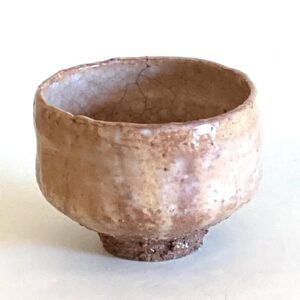
Cha-wan, 茶碗, tea-bowl, ceramic bowl with cream ro russet glaze, with rough surface kō-dai, 高台, high-support, ring foot, Hagi, 萩, Bush clover; h. 3.2 sun kane-jaku x diam. 4 sun kane-jaku, by Ki-mura Kō-ji, 喜村 皓司, Joy-village Clear-official, Hagi City.
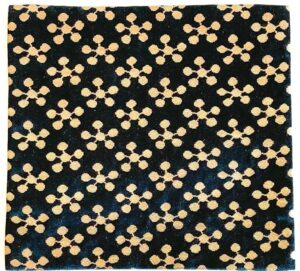
Ko-buku-sa, 古帛紗, old-cloth-gauze, blue-black silk with pattern in gold of Rikyū-bai kin-ran, 利休梅金襴, Rikyū-Japanese apricot gold-brocade. Keepsake from Urasenke after a week of intensive study and practice called kō-shū-kai, 講習会, lecture-learn-meeting. In a shrine rite, Ebisu is represented by a branch of ume, 梅, ‘prunus’, and Dai-koku-ten, 大黒天, Great-black-heaven (Deva), is represented by a bag of rice.

Cha-shaku, 茶杓, tea-scoop, take, 竹, bamboo, naka-bushi, 中節, middle-node (reversed), named, ‘Tsuri Zao’, 釣竿, Fishing Rod. The bamboo growth direction is from the handle to the scoop, as though an it is an extension of the arm, like a handle. A proper chashaku has the growth direction from the scoop to the handle, as though the bamboo grows from the tea and its container. Bearing the name of a fishing rod alludes to Ebisu’s fishing rod.
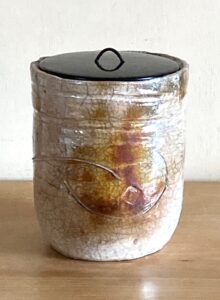
Mizu-sashi, 水指, water, ceramic with mottled glaze in the manner of American ‘raku’, by Ō-hi Toshi-o, 大樋年雄, Great-trough Year-male; H. 6 sun kane-jaku, made while he was a student at Boston University, in 1984. With a black lacquered wood lid.
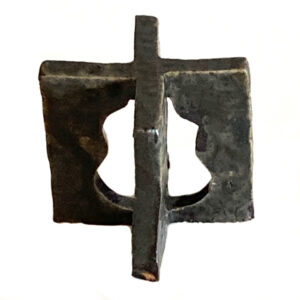
‘Hachiyo’ futa-oki, 八瓢 蓋置, Eight-gourds lid-place; ceramic X with an openwork image of a hisago, 瓢, gourd, with irregular black glaze, h. 1.8 sun kane-jaku, designed by Palmer and made by Steve Murphy, Boston Ceramics, Boston, Mass. Made as a remembrance of my reaching the age of 88, in Japanese, hachi-jū-hachi, 8 + 8. The character for 8 as in the West, is symbolic of infinity. Eight eights are symbolic of Infinity in Space. The shape of the gourd resembles the Arabic number 8. If written vertically in Kanji, 八十八, these three characters stacked together create the character for rice, 米. With this style of writing, the numbers make the character for rice, also called bei, kome, 米. The most auspicious age of 88 in Japanese is Bei-ju, 米寿, Rice-longevity. Eight times eight equals 64, which may evoke the 64 hexagrams of the I Ching, Eki-kyō, 易経, Change-sutra.
When using the Hachiyo as a futaoki, the piece is turned on its side with the gourd opening toward the fire. When displayed on a tana or board, the piece should be as pictured above.
Hachiyo is an obscure old expression for two or more things standing side by side. In Chanoyu, like life, a thing is more than just one thing.
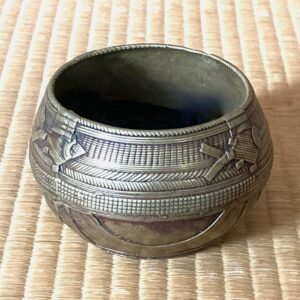
Rice measure, polished brass lost-wax cast molded with a ‘basket’ design of ropes and fish; h. 8.7 cm, (diam. 13.5 cm.) India. Used as a ken-sui, 建水, build-water, for waste water.
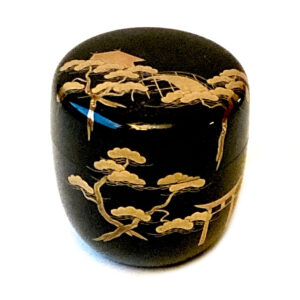
Natsume, 棗, jujube; black-lacquered, ovoid, covered container with ‘Sumi-yoshi maki-e,’ 住吉蒔絵, Live-well embed-picture, in gold and inlaid shell, by Take–uchi Kō-sai, 竹内幸斎, Bamboo-inside Blessing-abstain; H. 1.8 sun kujira-jaku.
Sumi-yoshi Tai-sha, 吉大社, Live-well Great-shrine, in the city of Ōsaka, is an important Shintō shrine founded in 211, by decree of Empress Jingū, 神宮転の. At Sumiyoshi Taisha, three gods of the sea and war are revered, together with Emperor Ō-jin Ten-nō, 応神天皇, Apply-god Heaven-emperor, who was deified as Hachi-man, 八幡, Eight-banners, the Empress Jin-gū, 神功, God-achieve, and others.
The bridge, named ‘Sori-hashi’ 反橋, Arch-bridge, on the sacred grounds of Sumiyoshi Taisha, is believed to have been dedicated by Toyo-tomi Hide-yoshi, 豊臣秀吉, Excel-subject Surpass-luck.
Oiemoto of Urasenke frequently offers Ken-cha, 献茶, Offer-tea, at Sumiyoshi Taisha in October on an auspicious day.
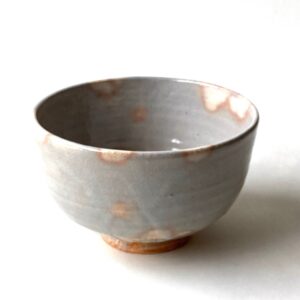
Cha-wan, 茶碗; tea-bowl; gray and pink glazed ceramic, O-suna yaki, お砂焼, Hon.-sand fired, by Kawa–hara Tō–sai, 川原陶斎, River-field Ceramic-abstain, Miya-jima–guchi, 宮島口, Palace-island-mouth. Made for Itsuku-shima Jin-ja, 厳島神社, Strick-island God-shrine; sand from the beach around the shrine is incorporated with the clay, which gives the variations in the glaze of the bowl. People used to collect a handful of sand from the shrine, as a sacred souvenir.
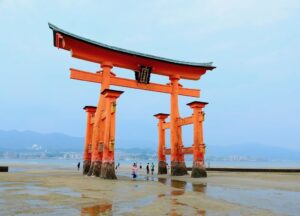
Itsukushima Jinja is dedicated to the three daughters of the Shinto deity of seas and storms, Susanoo-no-Mikoto.
The three princesses goddess ‘daughters’ of Amaterasu created by transmuting the sword of Susanoo are known by various names. Regardless of the name, however, each ends with either [no] kami, の神, god, or [no] mikoto, 命, fate; i.e., Ta-gi-tsu-hime-no-kami, 湍津姫神, or Ta-gi-tsu-hime-no-mikoto, 湍津姫命. All three deities are associated with different aspects of water, as they are technically the offspring of Susanoo, the god of the sea. Frequently, they are depicted in a boat on the sea in the following manner:
Ta-kiri-hime, 田心姫, Field-heart-princess, wears a green garment, and holds with both hands a Shintō go-hei, 御幣, hon.-staff with paper pendants. She is identified with mist.
Ichi-ki-shima-hime, 市杵島姫, Town-pestle-island-princess, wears an orange garment, her hands are concealed except for two fingertips. She is identified with the sea.
Ta-gi-tsu-hime, 湍津姫, Rapids-port-princess, wearing a blue garment, and holds an ōgi, 扇, (folding)fan, in her right hand. She is identified with rushing water.
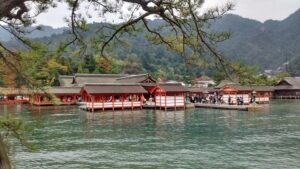
Urasenke offers Tea annually at the shrine in the month of October. The Iemoto of Urasenke presents a Kencha offering of both thick tea and thin tea at the main hall that enshrines the three goddesses. Itsukushima is an important cultural and spiritual location, and is a World Heritage site.
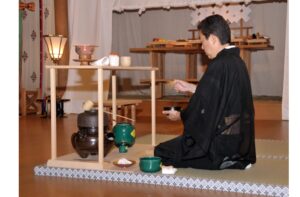
Urasenke Oiemoto offering Kencha at Itsukushima Jinja. The da-isu, 台子, support-of, display stand presentation includes the offering and a charcoal fire, thick and thin tea. Koi-cha, 濃茶, thick-tea, is kept in a plain wooden natsume, 棗, jujube, lined in gold, and wrapped in a white silk shi-fuku, 仕服, serve-cover, tied with a purple cord, and usu-cha, 薄茶, thin-tea is in a separate natsume lined in silver and wrapped in a white silk shifuku tied with a red cord. The Kencha is typical of Tea offerings.
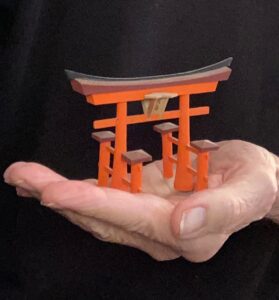
In the solar calendar, the 26th of November, 2025, corresponds with Kyū I-no-ko Mochi, 旧亥の子餅, Old Boar’s Rat Mochi, signaling the transition from the period of the Boar to the period of the Rat. This will be the official solar transition for some Tea people to change from the furo to the ro. Because of the difference in lunar and solar date, other people will choose to open the ro at the beginning of November. Now is the time to appreciate the final days of furo season of the year, before the new tea, the new rice, and the new beans are ready to enjoy.
For further study, see also: Nakaoki Collection

